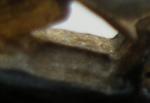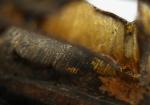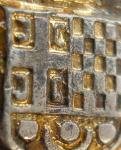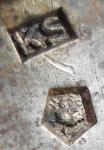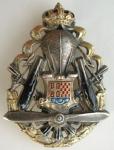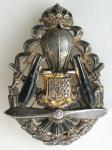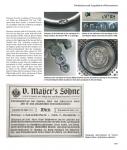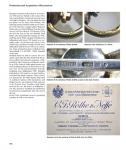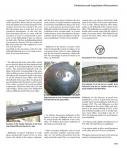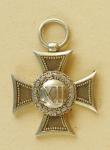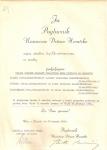
bovec1313
Past Contributor-
Posts
155 -
Joined
-
Last visited
Content Type
Profiles
Forums
Blogs
Gallery
Events
Store
Everything posted by bovec1313
-
Hi Lilo; to be honest, I've found it easier to copy all the text about Commemoravive medal and post it here than cut out of it. if anybody have interest, please read... If not, skip it. It's from the book Decorations of Serbia and Yugoslavia 1858 - 1941 The Commemorative Medal for the Serbo – Turkish Wars of 1876 – 1878 was awarded to all persons who had taken part in the wars of 1876, and 1877/78 as combatants or non-combatants in recognition of ‘…sacrifices made and services rendered for independence and liberation…’ The same law laid down the design of the commemorative medal and it was stated that ‘ the commemorative medal should be worn on the left of the chest, on a rectangular ribbon as follows: combatants on a red ribbon with blue edges and non-combatants on a blue ribbon, which is wide and folded the same way as the ribbon for the Silver Medal for Valour’. On 26 April 1878 the war ministry issued detail instructions on the awarding of the medal. The medal was to be awarded to all officers, NCOs, other ranks of (the regular and territorial armies) of the regular army and national (reserve) army and members of volunteer units, who had contributed towards ‘any military or wartime mission of the active Serbian army’. The medal for combatants was also awarded to members of medical units, army chaplains and administrative personnel ‘who had performed their duty and assignments on the battlefield under enemy fire’. Persons decorated with the Medal for Valour automatically also received the commemorative medal for combatants. The medal on the ribbon for non-combatants was awarded to all mobilized officers, NCOs, other ranks and medical personnel who had not seen combat action against the Turks. The medal has a diameter of 33 mm. The obverse bears the crowned monogram of Prince Milan Obrenovich ‘MO IV’, surrounded by a laurel (left) and oak (right) branch. The branches are twisted around a bandeau bearing an inscription commemorating the major battles of the Serbo - Turkish Wars. The names Shumatovac/Nish/Ak Palanka/Pirot are placed on the left and Grdelica/Vranja/St. Nikola/Adlije on the the right. The reverse of the medal shows an allegorical figure of a standing woman, symbolizing Serbian victory, and holding a laurel branch in one hand and a cross in the other. The figure is leaning on a shield with the Serbian coat of arms. The Turkish flag and military trophies are placed under her feet. The central motif is surrounded by a border with the Cyrillic inscription: ‘War for Liberation and Independence 1876-1877-1878’. A certain amount of confusion occurred when the commemorative medal was first issued. Most officers and other ranks placed the more decorative reverse of the medal to the front, which was, of course, contrary to regulations. This can be seen on many photographs. The medal was manufactured in a considerable number of variants, which indicates the large quantity of awards and its great popularity. The first medals were manufactured immediately after its institution by the law. The medals have a characteristic fixed eye-loop, which was made of one piece with the medal. Several variants exist differing in material, thickness and some details. The medal was produced almost until the end of the century and medals of later production can easily be distinguished by the ball or cylindrical shape of the eye-loop. However, these later models also differ in some variants. The ribbons for medals manufactured in 1878 were made exactly according to regulations, 28 mm wide, purple in colour and with 4-mm-wide blue edges. Later ribbons were folded into a triangle and vary in the nuance of the colour, as they were manufactured by different firms. Most medals were made of brass or gilt bronze. Some medals were silver-plated, which was contrary to regulations. In the collection of the National Museum in Belgrade there is a medal made of 18 carat gold. The hallmarks of the workshop of Vincent Mayer’s Söhne are on the edge and the eye-loop bears the hallmark for 18 carat gold. A number of Viennese workshops were included in the production of this medal. According to the documents available and information from W. M. Edler von Müllersheim, the majority of medals were manufactured by the workshop of Johann Schwerdtner. Other manufacturers mentioned are the firms of Adolf Müller, Pittner and Christlbauer. Considering the large number of variants, it can be assumed that the list of producers is probably longer. As the medal was not made of precious metal, manufacturers did not hallmark their products, so it is impossible to link a specific variant of the medal to a specific workshop. According to unofficial estimates, it is reckoned that about 200,000 commemorative medals were manufactured. Due to the poorly organized distribution of the medals, as late as 1890, the depots of the war ministry and some senior headquarters contained ‘a considerable quantity of Commemorative Medals for the Serbo - Turkish wars of 1876 – 1878, which were acquired in appropriate numbers by the army in both wars and which were not distributed to those who had the right to receive them’ (Official Military Gazette, 1890, no. 96, 11). Obverse of medal with older ribbon
-
Yugoslavia - Fakes of the ''Balloon badge''
bovec1313 replied to bovec1313's topic in Southern European & Balkan States
-
Yugoslavia - Fakes of the ''Balloon badge''
bovec1313 replied to bovec1313's topic in Southern European & Balkan States
-
Yugoslavia - Fakes of the ''Balloon badge''
bovec1313 replied to bovec1313's topic in Southern European & Balkan States
-
Yugoslavia - Fakes of the ''Balloon badge''
bovec1313 replied to bovec1313's topic in Southern European & Balkan States
-
Yugoslavia - Fakes of the ''Balloon badge''
bovec1313 replied to bovec1313's topic in Southern European & Balkan States
-
Yugoslavia - Fakes of the ''Balloon badge''
bovec1313 replied to bovec1313's topic in Southern European & Balkan States
-
Yugoslavia - Fakes of the ''Balloon badge''
bovec1313 replied to bovec1313's topic in Southern European & Balkan States
-
Lately a number of the fakes of the so called ''Balloon Badge'' of the Yugoslav Royal Air Force have appeared on the marked. (In fact the proper name is Badge for Flight Mechanics, but due to image of the balloon in central part, badge got popular name ''Balloon Badge'') As badge is extreme rarity and thus expensive, I would like to point out some detail how collectors can recognize fake from original. Original is forged from silver and fakes are (usually) made by casting, as well form silver. Even that casted fakes are made extremely good, they still differ in some details. Hallmarks; badge is always hallmarked with producers hallmark (FS for Fran Sorlini) and with silver hallmark (a rooster). On original, under the magnifying glass hallmarks are still crystal clear, while on fakes hallmarks are rather smooth. Flat surface; flat surface, for example on the cross in coat of arms, which is placed in the centre of badge, even looking under magnifying glass, surface is perfectly flat. On fakes, due to casting, in flat surface we can see that surface is not flat but have small wrinkles; edges are not sharp anymore. Edges; on forged badges holes were cut out with small saw ( handwork of course), and under magnifying glass we can see the remains of the saw-teeth. Fakes, which are cast, lack of this detail. There are more details, but these three above can be clearly recognized. I hope this will help collectors among you, who wanted to add this extraordinary badge in your collections. Bellow is an image of the original ''Balloon badge''
-
Hi Lilo, Emanuel is right; the only addition is that ribbon you have on Commemorative medal for Serbo - Turkish wars 1876 - 1878 is for combatant personnel; non-combatant personnel had received medal on plain pale-blue medal. Ribbon can be in triangle form or elongated; Elongated ribbons come in two sizes, 25 mm and 37 mm wide. Just to mentioned, awarded persons often placed medal with reverse shown as reverse bearing the image of victorious Serbia, as reverse was much more decorative in comparison to rather boring obvesre with royal cypher ''MIV''. This was of course against the regulations Red cross decoration of the 1st type (instituted in year 1876) was used until 1882; then it was replaced with 2nd model with crown. Attachment to the triangular ribbon was quite clumsy; badge was namely sawn on the ribbon trough rectangular opening. Crosses are both hallmarked and non-hallmarked; they were produced by Viennese workshops of Rothe & Neffe (hallmarked FR) and Vincent Mayer's Sohne (hallmarked VM). I'm including picture of the Commemorative Medal on elongated non-combatants ribbon.
-
Hello Yankee, thanks for nice words; I would be happy to provide you a copy, in English, I believe. The book exist as well in German language. price is 99 Euro, but I can give you some discount, to a colleague collector. Post expenses depends on your location, pof course. USA, I presume. regards, Pavel
-
I would definitely agree with Yankee, Paul and Enzo that Austrian hallmarks are a very complex topic. To clerify some issues about famous ''tax free'' hallmark and Rothe's hallmark (one of the most eminent producers of Austrain decoratios) , I would like to add some points which I've come across when doing research about Austrian producers and hallmarks. I'm presenting here some text parts and pictures from my book Serbian and Yugoslav Orders and Decorations 1858 – 1941. Namely, until 1914, all Serbian decorations were manufactured in Vienna. (there are 30 pages of producers & hallmarks in the book) ''Between 1872 and 1922 the Viennese Assay Office registered about 2,400 (!!) master craftsmen and their workshops manufacturing small artifacts of precious metals. Many of them were producers of decorations.'' I was lucky to be able to study this famous Register of workshops of the Viennese Assay Office (Amtspunzierung Wien), where each and every craftsman has his own hallmark shown; some of them even two or three. In addition, every producer has a detail specification what kind of products or jewelry can produce. Allowance for production of orders is specified as well. ''Until 1922 the products of Rothe & Neffe were hallmarked with 'FR' placed in a rhombus (Amtspunzierung registration number 711; II/158). Over the same period Christian Rothe also used the hallmark which was entered under his personal name in the register of workshops of the Viennese Assay Office (Amtspunzierung Wien). His personal hallmark was in the form of the letters 'FR' placed in a rectangle, with a dot between the letters (Amtspunzierung registration number 722; II/158). This hallmark appeared on decorations made in the early period of workshop production. The marking 'C. F. ROTHE - WIEN' is stamped on the pins. ……. ''The workshop of Rothe & Neffe was famous for producing replicas of Austro-Hungarian and other world orders of the highest quality. The first replicas were made in the early 1930s, usually for recipients who had sold their gold decorations from the time of the Austro-Hungarian Monarchy in the postwar crisis and replaced them by decorations manufactured later. Most of these decorations were made of bronze, but some of silver. They were automatically hallmarked 'CFR', the mark used by the firm of Rothe & Neffe after 1922. After the Second World War Emil Rothe started producing new replicas, most of which he manufactured himself. To begin with, these decorations were ordered by museums and a few collectors, but when the workshop became linked to the auction house of Graf & Klenau in Munich, mass production started for the needs of collectors. All order badges manufactured at this time were made of silver and are usually hallmarked 'CFR'. As regards order stars, they are only marked with the workshop marking, which is placed on the pin. Otherwise they have no markings. After Emil Rothe's death in 1972, the company was taken over by his daughters Susanne and Elisabeth Rothe. Albeit trained goldsmiths, the sisters had never produced decorations themselves so this work was entrusted to a craftsman and employee of the workshop. Production lasted until the end of the 1980s and was discontinued when the craftsman went to retirement. The Rothe sisters retired in 2004 and 'Hollauerhaus' at Kohlmarkt 7 in Vienna closed its doors for good.'' '' Other secondary hallmarks, such as stock marks, inventory numbers, museum markings, etc. On Serbian decorations from the early period the mark 'Frei' can often be found, or exempt from customs duty, and a hallmark in the shape of the Latin capital letter 'A' in a circle, which collectors often misinterpret as the hallmark of the Viennese Assay office. This hallmark can usually be found on medals and it merely states that the object is made of precious metal. This hallmark was used by the State Mint, where most medals were manufactured. '' As you can see from pictures bellow, hallmark ''FREI'' is quite different from Rothe's hallmark FR, and this one is very very often mistaken. Practically, ''FREI'' hallmark can't be found on Austrian orders and medals, as it was placed only on product which was exported from Austria (and nobody was exporting Austrian orders, naturally). However, even on exported items this hallmark is very rarely seen. I was inspecting many thousands of Serbian orders made in Vienna (and exported to Serbia) but I haven't seen not a single one ''FREI'' hallmark. Bellow: FR hallmark of Rothe and Neffe in rhombus and personal hallmark of Christian Rothe, FR in rectangle, with dott between letter
-
I've come across many Officers' Service Crosses with an engraved inscription, but for the first time I've found a Non-commissioned Service Cross with an engraved inscription. It's a cross for 12 years of service. Reverse bears an inscription (translated) ''17.8. / From Officers Corps of Infantry Regiment No. 6 / 1907''. Cross is made from silver (!!) and it's hallmarked on the edge of central medallion with silver hallmark for silver 900/1000 and producer's hallmark ''VM'' for Vincent Mayer's Sohne, prestigious Viennese producer. This decoration was accompanied with Silver Cross for Merits with Crown, again with engraved inscription, similar to previous one, only the date is different, namely 12.VIII.1913. Obviously, these two decorations had belonged to an non-commissioned officer, which was highly praised from officers of the 6th Infantry Regiment, which was not the common case in KuK Armee, where officers ''lived'' in a different world in comparison to Non-commissioned officers and enlisted men.
-
Serbia Decoration/Plaque - Drvar
bovec1313 replied to wlodzimierz's topic in Southern European & Balkan States
The opposite site... Decree for Croatian Large Silver Medal for Bravery, for 3 German soldiers, members of ''Special units'' (Sonderformation) who took part on assault on Drvar. Document is signed by Croatian führer Ante Pavelic and Minister of war, Ustascha general Ante Vokic. Large Medal for Bravery was quite a rare and high decoration, as only 744 medals were awarded to Croatian troops during WW2. On decree it is written that decoration is awarded '' for brave conduct during the attack on ''Tito's'' HQ and capturing of Drvar from 25 until 29 of May 1944'' -
Yugoslavia Primeran vojnik breast badge
bovec1313 replied to SasaYU's topic in Southern European & Balkan States
Addition comments on ''primeran vojnik'' breast badge. I was serving in former JNA (Yugoslav People's Army) for a year. The first 6 months soldiers had initial training in their arm branch (I was infantry). After 6 month they become so called ''old army'' and many of soldiers were posted on different duties in barracks (kuriers, administrative work, canteen, kitcheen, guards, various craftsmen, etc). After initial training badge ''primeran vojnik'' was distributed to every company. As I remember, 2-3 were awarded to company of 200 soldiers. I don't remember much about grades, in spite of fact we were evaluated in many areas during initial training. But for badge best solders from the company were chosen, not only from military skills but as well from right ''political orientation''. Between soldiers, badge was very highly praised. Not because of glory, this came collateral, but with badge 14 days leave was granted to every awarded soldier. It was possible not to take leave, but to left it on the end and finished service in the army 14 days earlier. And this was something indeed. Sharpshooters medals were awarded as well, about 5-6 to company, but these had no leave attached. I was awarded with none of them. -
I'm posting pictures of my Order of the National Liberaiton, the 1st model. These orders were later replaced by the 2nd, star-shape model. Thse were manufactured in IKOM. Old awards were collected back. in spite of fact that over 5000 Orders were produced in Soviet Union, only handfull survived in collections. All the rest were later melted. My example, numbered ''1014'' was awarded either to Edvard Kardelj, Slovene and one of most eminent communist political figures in Yugoslavia; a ''great'' theoretic of communist science and inventor of socalled self management, either to his wife Pepca Kardelj.
-
Most of the decorations of Socialistic Yugoslavia are numbered with serial numbers on reverse. Many collectors consider lower serial numbers as ''better items'', as it is the case with many Soviet awards. But in Yugoslavia lower serial number, especially on high classes, doesn't mean always an early award. Namely, during the war, when delivered from Soviet Union, packages with decorations were sent to various parts of Yugoslavia to local partisan HQ (i.e. to Slovenian partisans, Croat partisans, Macedonian etc.). Packages with decorations were briefly opened and decorations awarded. Serial numbers, which were entered in respective certifications (uvjerenje), just follow the serial numbers from the orders from the package. I have in my collection Order on National Liberation (the 1st, Soviet made model) with serial number 1014. I've seen two more in Slovenia, booth numbered between 1010 and 1020. It's clear that package with these decorations sent to Slovenia consisted orders with serial numbers started from (most likely) 1000. In fact only 262 awards were made in total until year 1985. I've got a certification (uverenje) for the Order of Partisan Star Class I (with golden wreath), awarded to Hero of Yugoslavia, Petar Brajovich. He was awarded on December 6, 1944 (one of the first awards), but it's serial number (as stated on certification) is 963 (!!). And all together only 627 awards were made in total. Most likely, package with Partisan stars Class I for Serbia contained orders starting with serial numbers 900 or maybe 950. (I'm guessing). It's interesting, that on certification, P. Brajovich doesn't have stated his rank (major general), but he's addresses as CORPS COMMANDER. Certification was issued to him almost a year later, on October 1945. With decorations, which were in vast numbers awarded after the war (as Order of Brotherhood and Unity, Order Merits to the People, Order of Work), lower number definitively means earlier award.


